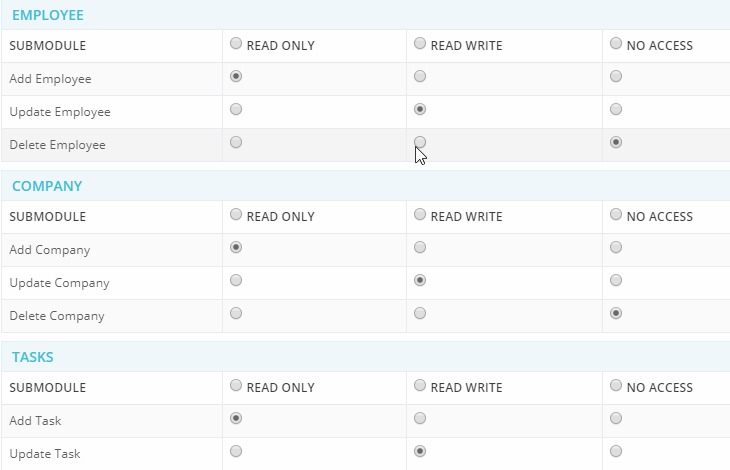Angular 8 Radio列表示例:
源链接

JSON回应
[
{
"moduleId": 1,
"moduleName": "Employee",
"subModules":[
{
"subModuleId": 1,
"subModuleName": "Add Employee",
"selectedRightType": 1,
},{
"subModuleId": 2,
"subModuleName": "Update Employee",
"selectedRightType": 2,
},{
"subModuleId": 3,
"subModuleName": "Delete Employee",
"selectedRightType": 3,
}
]
},
{
"moduleId": 2,
"moduleName": "Company",
"subModules":[
{
"subModuleId": 4,
"subModuleName": "Add Company",
"selectedRightType": 1,
},{
"subModuleId": 5,
"subModuleName": "Update Company",
"selectedRightType": 2,
},{
"subModuleId": 6,
"subModuleName": "Delete Company",
"selectedRightType": 3,
}
]
},
{
"moduleId": 3,
"moduleName": "Tasks",
"subModules":[
{
"subModuleId": 7,
"subModuleName": "Add Task",
"selectedRightType": 1,
},{
"subModuleId": 8,
"subModuleName": "Update Task",
"selectedRightType": 2,
},{
"subModuleId": 9,
"subModuleName": "Delete Task",
"selectedRightType": 3,
}
]
}
]
HTML模板
<div *ngFor="let module of modules_object">
<div>{{module.moduleName}}</div>
<table width="100%">
<thead>
<tr>
<th>Submodule</th>
<th>
<input type="radio" name="{{module.moduleName}}_head_radio" [(ngModel)]="module.selHeader" (change)="selAllColumn(module)" [value]="1"> Read Only
</th>
<th>
<input type="radio" name="{{module.moduleName}}_head_radio" [(ngModel)]="module.selHeader" (change)="selAllColumn(module)" [value]="2"> Read Write
</th>
<th>
<input type="radio" name="{{module.moduleName}}_head_radio" [(ngModel)]="module.selHeader" (change)="selAllColumn(module)" [value]="3"> No Access
</th>
</tr>
</thead>
<tbody>
<tr *ngFor="let sm of module.subModules">
<td>{{sm.subModuleName}}</td>
<td>
<input type="radio" [checked]="sm.selectedRightType == '1'" [(ngModel)]="sm.selectedRightType" name="{{sm.subModuleId}}_radio" [value]="1">
</td>
<td class="cl-left">
<input type="radio" [checked]="sm.selectedRightType == '2'" [(ngModel)]="sm.selectedRightType" name="{{sm.subModuleId}}_radio" [value]="2">
</td>
<td class="cl-left">
<input type="radio" [checked]="sm.selectedRightType == '3'" [(ngModel)]="sm.selectedRightType" name="{{sm.subModuleId}}_radio" [value]="3">
</td>
</tr>
</tbody>
</table>
</div>
